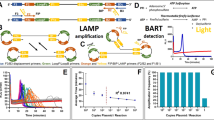Abstract
Standard-based real-time or quantitative polymerase chain reaction quantitation of an unknown sample’s DNA concentration (i.e., [DNA]unk) assumes that the concentration dependence of the standard and unknown reactions (related to reaction efficiency, E) are equivalent. In our work with background food-borne organisms which can interfere with pathogen detection, we have found that it is generally possible to achieve an acceptable E (1 ± 0.05) for standard solutions by optimizing the PCR conditions, template purity, primer sequence, and amplicon lengths. However, this is frequently not true for the solutions containing unknown amounts of target DNA inasmuch as cell extracts are more chemically complex than the standards which have been amplified (230-fold) as well as undergone a purification process. When significant differences in E occur, it is not possible to accurately estimate unknown target DNA concentration from the standard solution’s slope and intercept (from threshold cycle number, or C T , versus Log[DNA] data). What is needed is a standard-mediated intercept which can be specifically coupled with an unknown solution’s PCR concentration dependence. In this work, we develop a simple mathematical procedure to generate a new standard curve with a slope (∂C T /∂Log[Dilution]unk) derived from at least three dilutions of the unknown target DNA solution ([DNA]unk) and an intercept calculated from the unknown’s C T s, DNA concentrations interpolated from the standard curve (i.e., the traditional estimate of [DNA]unk), and ∂C T /∂Log[Dilution]unk. We were able to achieve this due to our discovery of the predictable way in which the observed and ideal C T versus Log[DNA] slopes and intercepts deviate from one another. This “correction” in the standard-based [DNA]unk determination is typically 20–60% when the difference in the standard and unknown E is >0.1.








Similar content being viewed by others
References
Chien A, Edgar DB, Trela JM (1976) Deoxyribonucleic acid polymerase from the extreme thermophile Thermus aquaticus. J Bacteriol 127:1550–1557
Bartlett JMS, Stirling D (2003) A short history of the polymerase chain reaction. Methods Mol Biol 226:3–6
Rabinow P (1996) Making PCR: a story of biotechnology. University of Chicago Press, Chicago, pp 6–7
Mackay IM (2004) Real-time PCR in the microbiology laboratory. Clin Microbiol Infect 10:190–212
Livak KJ, Schmittgen TD (2001) Analysis of relative gene expression data using real-time quantitative PCR and the 2ΔΔCt method. Methods 25:402–408
Yuan JS, Reed A, Chen F, Stewart CN Jr (2006) Statistical analyses of real-time PCR data. BMC Bioinform 7:85–96
He Y, Yao X, Gunther NW, Xie Y, Tu S-I, Shi X (2010) Simultaneous detection and differentiation of Campylobacter jejuni, C. coli, and C. lari in chickens using a multiplex real-time PCR assay. Food Analytical Methods 3:321–329
Bustin SA (2000) Absolute quantification of mRNA using real-time reverse transcription polymerase chain reaction assays. J Mol Endocrinol 25:169–193
Irwin PL, Nguyen L-HT, Chen C-Y (2010) The relationship between purely stochastic sampling error and the number of technical replicates used to estimate concentration at an extreme dilution. Anal Bioanal Chem 398:895–903
Pfaffi NW (2001) A new mathematical model for relative quantitation in real-time RT-PCR. Nucleic Acids Res 29:2002–2009
Schnell S, Mendoza C (1997) Theoretical description of the polymerase chain reaction. J Theor Biol 188:313–318
Ruijter JM, Ramakers C, Hoogaars WMH, Karlen Y, Bakker O, van den Hoff MJB, Moorman AFM (2009) Amplification efficiency: linking baseline and bias in the analysis of quantitative PCR. Nucleic Acids Res 37:1–12
Raeymaekers L (2000) Basic principles of quantitative PCR. Mol Biotechnol 15:115–122
Schnell S, Mendoza C (1997) Enzymological considerations for a theoretical description of the quantitative competitive polymerase chain reaction. J Theor Biol 184:433–440
Zar JH (1999) Biostatistical analysis. Prentice Hall, Upper Saddle River, pp 328–330
Irwin PL, Nguyen L-HT, Chen C-Y, Paoli G (2008) Binding of nontarget microorganisms from food washes to anti-Salmonella and anti-E. coli O157 immunomagnetic beads: most probable composition of background Eubacteria. Anal Bioanal Chem 391:525–536
Cottrell MT, Kirchman DL (2000) Community composition of marine bacterioplankton determined by 16S rRNA gene clone libraries and fluorescence in situ hybridization. Appl Environ Microbiol 66:5116–5122
Ririe KM, Rasmussen RP, Wittwer CT (1997) Product differentiation by analysis of DNA melting curves during the polymerase chain reaction. Anal Biochem 245:154–160
Morrison TB, Weis JJ, Wittwer CT (1998) Quantification of low-copy transcripts by continuous SYBR Green I monitoring during amplification. Biotechniques 24:954–962
Steele RGD, Torrie JH (1960) Principles and procedures of statistics. McGraw-Hill, New York, 481 pp
Author information
Authors and Affiliations
Corresponding author
Additional information
Reference to a brand or firm name does not constitute endorsement by the U.S. Department of Agriculture over others of a similar nature not mentioned. The USDA is an equal opportunity provider and employer.
Rights and permissions
About this article
Cite this article
Irwin, P.L., Nguyen, LH.T., Chen, CY. et al. A method for correcting standard-based real-time PCR DNA quantitation when the standard’s polymerase reaction efficiency is significantly different from that of the unknown’s. Anal Bioanal Chem 402, 2713–2725 (2012). https://doi.org/10.1007/s00216-012-5737-9
Received:
Revised:
Accepted:
Published:
Issue Date:
DOI: https://doi.org/10.1007/s00216-012-5737-9




